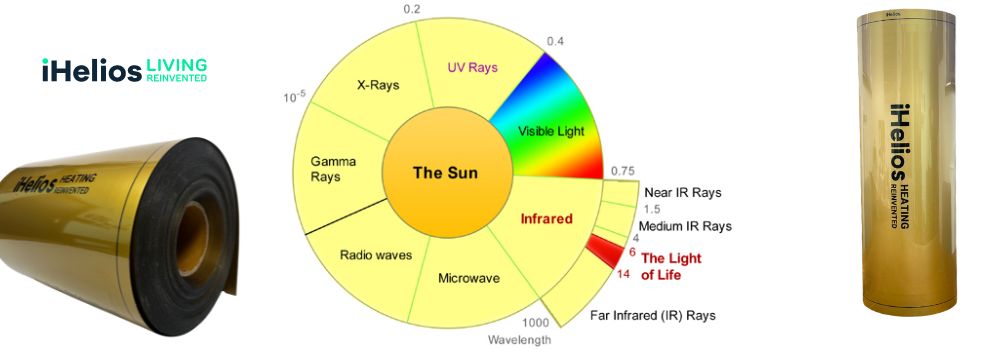
Understanding Infrared: Near, Mid, and Far-Infrared
Share
Understanding Types of Infrared Radiation and the iHelios Advantage
Infrared radiation plays a crucial role in heating technology.
However, not all infrared is the same.
Infrared radiation is divided into three types: near-infrared, mid-infrared, and far-infrared.
Each has distinct characteristics that affect its safety and usage.
Understanding these differences is key to choosing the best heating system for your home or office.
Types of Infrared Radiation
1. Near-Infrared (NIR)
Near-infrared has the shortest wavelength and highest frequency among the three types.
Because of its intensity, NIR can excite atoms more vigorously, potentially causing burns upon exposure.
In fact, excessive exposure to near-infrared radiation has been linked to retinal damage in the eyes.
Therefore, NIR is less suitable for home heating applications where long-term safety is essential.
2. Mid-Infrared (MIR)
Mid-infrared falls between near and far-infrared in terms of wavelength and frequency.
Although it offers intermediate properties, it is less commonly discussed regarding heating systems.
Typically, MIR is used in specialized industrial applications rather than in everyday heating solutions.
3. Far-Infrared (FIR)
Far-infrared has the longest wavelength and lowest frequency, making it the safest and most beneficial type for heating.
Often called the "light of life," FIR comprises about 49% of the sun’s infrared output.
It is widely used in settings requiring gentle and safe warmth, such as incubators for newborn babies.
Most importantly, far-infrared is ideal for residential and commercial heating systems because it delivers safe, even warmth.
Benefits of Far-Infrared Heating
Far-infrared heating offers significant advantages over traditional air-based systems.
Energy Efficiency
Unlike convection heaters that warm the air, far-infrared systems heat surfaces and objects directly.
These objects then slowly release stored heat back into the room, maintaining a stable temperature.
As a result, the system can operate for shorter periods, leading to lower energy consumption and reduced utility bills.
Comfort and Health Benefits
Far-infrared heating creates a consistent and comfortable temperature throughout the space.
Moreover, it reduces drafts and dry air, common issues with conventional systems.
This makes far-infrared heating especially beneficial for individuals with respiratory sensitivities or allergies.
iHelios Far-Infrared Heating Film: Innovative and Safe
While many far-infrared systems exist, not all are created equally.
The iHelios far-infrared heating film stands out for its innovative design and commitment to safety.
Addressing the Limitations of Traditional Infrared Panels
Traditional far-infrared panels can become extremely hot, posing risks to children, elderly people, and pets.
They also often produce uneven heating, creating uncomfortable hot and cold spots.
Why Choose iHelios Heating Film?
The iHelios solution addresses these challenges with a smarter design:
-
Uniform Heating: iHelios heating films distribute heat evenly, eliminating cold zones across the room.
-
Touch-Safe Design: The surface temperature remains safe, even when touched — perfect for family homes.
-
Energy Efficiency: Fast heating and optimized energy usage lead to lower electricity bills and a smaller carbon footprint.
Therefore, iHelios provides a safer, more reliable, and eco-friendlier heating option compared to traditional panels.
Conclusion: A Smarter Way to Heat Your Space
Far-infrared heating — especially through advanced systems like iHelios — offers a superior alternative to conventional methods.
By focusing on safety, energy efficiency, and comfort, iHelios ensures your home remains warm, welcoming, and sustainable.
Choose iHelios for a healthier, smarter, and more energy-efficient way to heat your living or working spaces.
